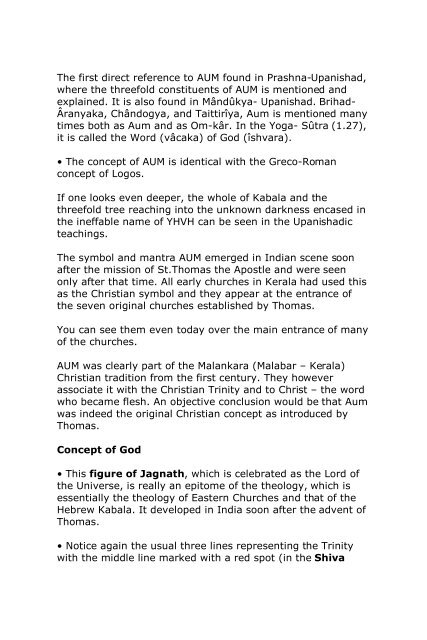Rewriting Hindu History-How do they do it
You also want an ePaper? Increase the reach of your titles
YUMPU automatically turns print PDFs into web optimized ePapers that Google loves.
The first direct reference to AUM found in Prashna-Upanishad,<br />
where the threefold const<strong>it</strong>uents of AUM is mentioned and<br />
explained. It is also found in Mândûkya- Upanishad. Brihad-<br />
Âranyaka, Chân<strong>do</strong>gya, and Ta<strong>it</strong>tirîya, Aum is mentioned many<br />
times both as Aum and as Om-kâr. In the Yoga- Sûtra (1.27),<br />
<strong>it</strong> is called the Word (vâcaka) of God (îshvara).<br />
• The concept of AUM is identical w<strong>it</strong>h the Greco-Roman<br />
concept of Logos.<br />
If one looks even deeper, the whole of Kabala and the<br />
threefold tree reaching into the unknown darkness encased in<br />
the ineffable name of YHVH can be seen in the Upanishadic<br />
teachings.<br />
The symbol and mantra AUM emerged in Indian scene soon<br />
after the mission of St.Thomas the Apostle and were seen<br />
only after that time. All early churches in Kerala had used this<br />
as the Christian symbol and <strong>they</strong> appear at the entrance of<br />
the seven original churches established by Thomas.<br />
You can see them even today over the main entrance of many<br />
of the churches.<br />
AUM was clearly part of the Malankara (Malabar – Kerala)<br />
Christian trad<strong>it</strong>ion from the first century. They however<br />
associate <strong>it</strong> w<strong>it</strong>h the Christian Trin<strong>it</strong>y and to Christ – the word<br />
who became flesh. An objective conclusion would be that Aum<br />
was indeed the original Christian concept as introduced by<br />
Thomas.<br />
Concept of God<br />
• This figure of Jagnath, which is celebrated as the Lord of<br />
the Universe, is really an ep<strong>it</strong>ome of the theology, which is<br />
essentially the theology of Eastern Churches and that of the<br />
Hebrew Kabala. It developed in India soon after the advent of<br />
Thomas.<br />
• Notice again the usual three lines representing the Trin<strong>it</strong>y<br />
w<strong>it</strong>h the middle line marked w<strong>it</strong>h a red spot (in the Shiva


















